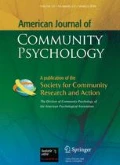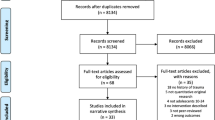Abstract
Adolescents are at high risk for violence exposure and initiation of drug use. Co-occurring substance use and trauma exposure are associated with increased risk of mental health disorders, school underachievement, and involvement with multiple systems of care. Coordination and integration of systems of care are of utmost importance for these vulnerable youth. This study delineates the negative sequelae and increased service utilization patterns of adolescents with a history of trauma, substance abuse, and co-occurring trauma and substance abuse to support the need for integrated mental health and substance abuse services for youth. Data from two national sources, the National Child Traumatic Stress Network and Center for Substance Abuse Treatment demonstrate the increased clinical severity (measured by reports of emotional and behavioral problems), dysfunction, and service utilization patterns for youth with co-occurring trauma exposure and substance abuse. We conclude with recommendations for an integrated system of care that includes trauma-informed mental health treatment and substance abuse services aimed at reducing the morbidity and relapse probability of this high-risk group.

Similar content being viewed by others
References
Achenbach, T. (2001). Child behavior checklist/6–18 years. Burlington: University of Vermont.
Allen, J., & Colombus, M. (Eds.). (2003). Assessing alcohol problems: A guide for clinicians and researchers (2nd ed.). Rockville, MD: National Institute on Alcohol Abuse and Alcoholism.
American Psychiatric Association (APA). (1994). Diagnostic and statistical manual of mental disorders (4th ed.). Washington, DC: Author.
American Psychiatric Association (APA). (2000). American Psychiatric Association diagnostic and statistical manual of mental disorders (4th ed., text revision ed.). Washington, DC: American Psychiatric Association.
Anda, R. F., Dong, M., Brown, D. W., Felitti, V. J., Giles, W. H., Perry, G. S., et al. (2009). The relationship of adverse childhood experiences to history of premature death of family members. BMC Public Health, 9, 106. doi:10.1186/1471-2458-9-106.
Anda, R. F., Whitfield, C. L., Felitti, V. J., Chapman, D., Edwards, V. J., Dube, S. R., et al. (2002). Adverse childhood experiences, alcoholic parents, and later risk of alcoholism and depression. Psychiatric Services, 53, 1001–1009.
Back, S. E., Brady, K. T., Sonne, S. C., & Verduin, M. L. (2006). Symptom improvement in co-occurring PTSD and alcohol dependence. Journal of Nervous and Mental Disease, 194, 690–696.
Back, S., Dansky, B. S., Coffey, S. F., Saladin, M. E., Sonne, S., & Brady, K. T. (2000). Cocaine dependence with and without post-traumatic stress disorder: A comparison of substance use, trauma history and psychiatric comorbidity. American Journal of Addiction, 9(1), 51–62.
Blumenthal, H., Blanchard, L., Feldner, M. T., Babson, K. A., Leen-Feldner, E. W., & Dixon, L. (2008), Traumatic event exposure, posttraumatic stress, and substance use among youth: A critical review of the empirical literature. Current Psychiatry Reviews, 4, 228–254.
Brady, K. T., Killeen, T. K., Brewerton, T., & Lucerini, S. (2000). Comorbidity of psychiatric disorders and posttraumatic stress disorder. Journal of Clinical Psychiatry, 61(Suppl 7), 22–32.
Brown, D. W., Anda, R. F., Felitti, V. J., Edwards, V. J., Malarcher, A. M., Croft, J. B., et al. (2010). Adverse childhood experiences are associated with the risk of lung cancer: A prospective cohort study. BMC Public Health, 10 (20). doi:10.1186/1471-2458-10-20.
Brown, D. W., Anda, R. F., Tiemeier, H., Felitti, V. J., Edwards, V. J., Croft, J. B., et al. (2009). Adverse childhood experiences and the risk of premature mortality. American Journal of Preventive Medicine, 37(5), 389–396.
Bukstein, O. G., & Horner, M. S. (2010). Management of the adolescent with substance use disorders and comorbid psychopathology. Child and Adolescent Psychiatric Clinics of North America, 19, 609–623.
Calsyn, R. J., Winter, J. P., & Morse, G. A. (2000). Do consumers who have a choice of treatment have better outcomes? Community Mental Health Journal, 36, 149–160.
Chilcoat, H. D., & Breslau, N. (1998a). Investigations of causal pathways between PTSD and drug use disorders. Addictive Behaviors, 23, 827–840.
Chilcoat, H. D., & Breslau, N. (1998b). Posttraumatic stress disorder and drug disorders: Testing causal pathways. Archives of General Psychiatry, 55, 913–917.
Cohen, J. A., Mannarino, A. P., Zhitova, A. C., & Capone, M. E. (2003). Treating child abuse related posttraumatic stress and comorbid substance abuse in adolescents. Child Abuse Neglect, 27(12), 1345–1365.
Copeland, W., Keeler, G., Angold, A., et al. (2007). Traumatic events and posttraumatic stress in childhood. Archives of General Psychiatry, 64, 577–584.
Danielson, C. K., Amstadter, A., Dangelmaier, R. E., Resnick, H. S., Saunders, B. E., & Kilpatrick, D. G. (2009). Does typography of substance abuse and dependence differ as a function of exposure to child maltreatment? Journal of Child and Adolescent Substance Abuse, 18, 323.
Dennis M. L., Titus, J. C., White, M. K., Hodgkins, D., & Webber, R. (2003). Global appraisal of individual needs: Administration guide for the GAIN and related measures.
Dube, S. R., Anda, R. F., Felitti, V. J., Edwards, V. J., & Croft, J. B. (2002). Adverse childhood experiences and personal alcohol abuse as an adult. Addictive Behaviors, 27, 713–725.
Dube, S. R., Fairweather, D., Pearson, W. S., Felitti, V. J., Anda, R. F., & Croft, J. B. (2009). Cumulative childhood stress and autoimmune diseases in adults. Psychosomatic Medicine, 71(2), 243–250.
Dube, S. R., Felitti, V. J., Dong, M., Chapman, D. P., Giles, W. H., & Anda, R. F. (2003). Childhood abuse, neglect, and household dysfunction and the risk of illicit drug use: the adverse childhood experiences study. Pediatrics, 111, 564–572.
Finkelhor, D., Turner, H., Ormrod, R., & Hamby, S. L. (2009). Violence, abuse, and crime exposure in a nationally representative sample of children and youth. Pediatrics, 124(5), 1–13.
Giaconia, R. M., Reinherz, H. Z., Paradis, A. D., & Stashwick, C. K. (2003). Comorbidity of substance use disorders and posttraumatic stress disorder in adolescents. In P. Oimette & P. J. Brown (Eds.), Trauma and substance abuse: Causes, consequences, and treatment of comorbid disorders (pp. 227–242). Washington, DC: American Psychological Association.
Howard, M. O., Perron, B. E., Vaughn, M. G., Bender, K. A., & Garland, E. (2010). Inhalant use, inhalant-use disorders, and antisocial behavior: Findings from the national epidemiologic survey on alcohol and related conditions (NESARC). Journal of Studies on Alcohol and Drugs, 71, 201–209.
Hyer, L., Davis, H., Boudewyns, P., & Woods, M. G. (1991). A short form of the Mississippi Scale for Combat-Related PTSD. Journal of Clinical Psychology, 47, 510–518.
Latimer, W., & Zur, J. (2010). Epidemiologic trends of adolescent use of alcohol, tobacco, and other drugs. Child Adolescent Psychiatry Clinics of North America, 19, 451–464.
Laughame, R., & Priebe, S. (2006). Trust, choice and power in mental health: A literature review. Social Psychiatry and Psychiatric Epidemiology, 41, 843–852.
Lomba, L., Apostolo, J., & Mendes, F. (2009). Drugs and alcohol consumption and sexual behaviours in night recreational settings in Portugal. Adicciones, 21, 309–325.
Minkoff, K., & Cline, C. A. (2004). Changing the world: The design and implementation of comprehensive continuous integrated systems of care for individuals with co-occurring disorders. Psychiatric Clinics of North America, 27(4), 727–743.
Najavits, L. M., Gallop, R. J., & Weiss, R. D. (2006). Seeking safety therapy for adolescent girls with PTSD and substance abuse: A randomized controlled trial. Journal of Behavioral Health Services & Research, 33, 453–463.
National Institute on Drug Abuse. (2010). High school and youth trends. NIDA Info facts. Rockville, MD: U.S. Department of Health and Human Services.
O’Connell, M., Tondora, J., Croog, G., Evans, A., & Davidson, L. (2005). From rhetoric to routine: Assessing perceptions of recovery-oriented practices in a state mental health and addiction system. Psychiatric Rehabilitation Journal, 28(4), 378–386.
Oimette, P., & Brown, P. J. (2003). Trauma and substance abuse: Causes, consequences, and treatment of comorbid disorders (pp. 227–242). Washington, DC: American Psychological Association.
Sheedy, C. K., & Whitter, M. (2009). Guiding principles and elements of recovery-oriented systems of care: What do we know from the research? HHS publication No. (SMA) 09–4439. Rockville, MD: Center for Substance Abuse Treatment, Substance Abuse and Mental Health Services Administration.
Simpson, d, & Joe, G. (2003). A longitudinal evaluation of treatment engagement and recovery stages. Journal of Substance Abuse Treatment, 27(2), 89–97.
Steinberg, A. M., Brymer, M. J., Decker, K. B., & Pynoos, R. S. (2004). The University of California at Los Angeles post-traumatic stress disorder reaction index. Current Psychiatry Reports, 6, 96–100.
Strand, V. C., Sarmiento, T. L., & Pasquale, L. E. (2005). Assessment and screening tools for trauma in children and adolescents: A review. Trauma, Violence, & Abuse, 6, 55–78.
Stroul, B. A., & Friedman, R. M. (1986). A system of care for children and youth with severe emotional disturbances. Washington, DC: Georgetown University Child Development Center.National Technical Assistance Center for Children’s Mental Health.
Stroul, B., & Friedman, R. (1996). The system of care concept and philosophy. In B. Stroul (Ed.), Children’s mental health: Creating systems of care in a changing society (pp. 1–22). Baltimore, MD: Brookes Publishing.
Vaughn, M. G., Define, R. S., Delisi, M., Perron, B. E., Beaver, K. M., Fu, Q. et al. (2010). Sociodemographic, behavioral, and substance use correlates of reckless driving in the United States: Findings from a national Sample. Journal of Psychiatric Research [Epub ahead of press].
Winters, K. C. (Ed.). (1999). Screening and assessing of adolescents with a substance use disorder. Treatment Improvement Protocol (TIP) Series No. 31. Rockville, MD: Center for Substance Abuse Treatment.
Winters, K. C., Fahnhorst, T., Botzet, A. M., & Stinchfield, R. D. (2009). Assessing adolescent drug use. In R. Reis, D. Fiellin, S. Miller, & R. Saitz (Eds.), Principles of addiction medicine (4th ed., pp. 1429–1443). Baltimore, MD: Wolters Kluwer.
Acknowledgments
The authors would like to thank the youth and families that participated in the NCTSN and CSAT programs. The authors wish to express their appreciation for Judit Beres and Elizabeth Johnson for their assistance with this manuscript. The manuscript was supported by the following SAMHSA grants (1U79SM059297-01, 2U79SM056215, SM 3530249) and contract (Ref No. 270-07-0191). Analysis of the GAIN data reported in this paper was supported by Substance Abuse and Mental Health Services Administration’s (SAMHSA’s) Center for Substance Abuse Treatment (CSAT) using data provided by 119 grantees: TI16386, TI16400, TI16414, TI16904, TI16928, TI16939, TI16961, TI16984, TI16992, TI17046, TI17070, TI17433, TI17434, TI17446, TI17475, TI17484, TI17486, TI17490, TI17517, TI17523, TI17535, TI17604, TI17605, TI17638, TI17728, TI17755, TI17761, TI17763, TI17765, TI17769, TI17779, TI17786, TI17788, TI17812, TI17825, TI17830, TI13313, TI13344, TI13354, TI13356, TI13305, TI13322, TI13345, TI13308, TI13323, TI15678, TI15670, TI15486, TI15511, TI15433, TI15479, TI15682, TI15483, TI15674, TI15467, TI15686, TI15481, TI15461, TI15475, TI15413, TI15562, TI15514, TI15672, TI14376, TI14261, TI14189, TI14252, TI14315, TI14283, TI14267, TI14188, TI14272, TI14090, TI14271, TI14196, TI14311, TI15478, TI15447, TI15545, TI15671, TI15527, TI15489, TI15485, TI15524, TI15446, TI15466, TI15584, TI15438, TI15415, TI15421, TI15586, TI15469, TI15577, TI15458, TI15677, TI13601, TI13190, TI17476, TI17589, TI17646, TI17648, TI17673, TI17702, TI17719, TI17724, TI17742, TI17744, TI17751, TI17775, TI17817, TI17831, TI17864, TI18406, TI18587, TI18671, TI18723, TI19313, TI19323, and 655374.
Author information
Authors and Affiliations
Corresponding author
Additional information
The opinions expressed here belong to the authors and are not official positions of SAMHSA or the government.
Rights and permissions
About this article
Cite this article
Suarez, L.M., Belcher, H.M.E., Briggs, E.C. et al. Supporting the Need for an Integrated System of Care for Youth with Co-occurring Traumatic Stress and Substance Abuse Problems. Am J Community Psychol 49, 430–440 (2012). https://doi.org/10.1007/s10464-011-9464-8
Published:
Issue Date:
DOI: https://doi.org/10.1007/s10464-011-9464-8




